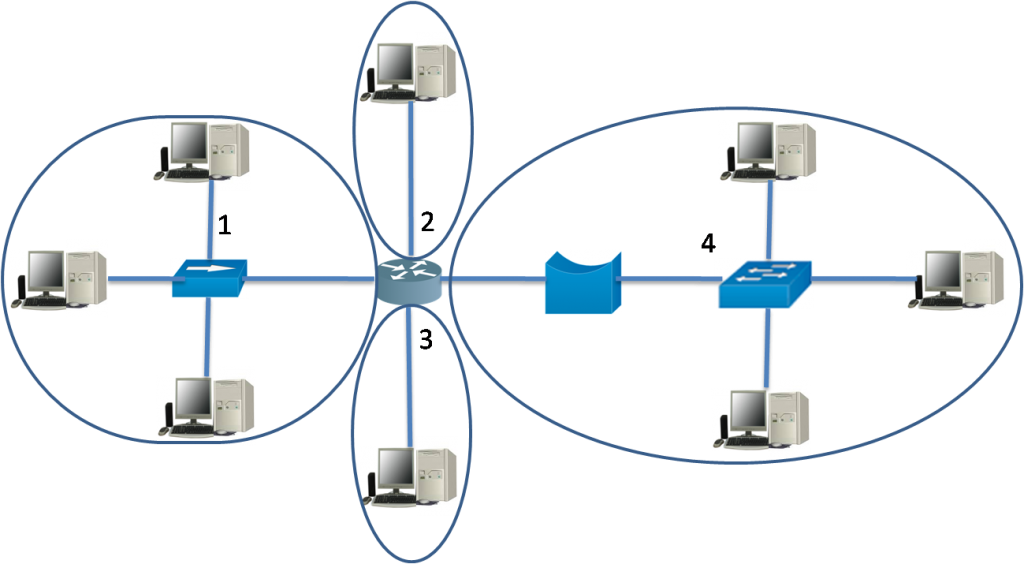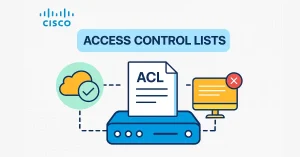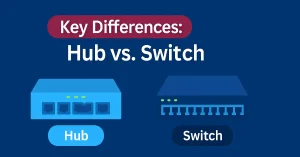In the realm of networking, understanding collision domains and broadcast domains is fundamental for designing efficient and scalable networks, a critical skill for CCNA and CCNP certifications. A collision domain represents a network segment where data packets may collide if multiple devices transmit simultaneously, a common challenge in older Ethernet setups like those using hubs. Conversely, a broadcast domain encompasses all devices that can receive Layer 2 broadcast frames, such as ARP requests, impacting performance in large networks.
As of June 29, 2025, with the evolution toward virtualized and IPv6-based infrastructures, managing these domains has become even more essential. This article explores the concepts, differences, and modern strategies—such as switches, routers, subnetting, and VLANs—to optimize network performance and troubleshoot issues effectively.
Collision Domain
The “collision domain” describes a network where packet collisions can occur when two devices on a shared network medium send packets simultaneously. The colliding packets are discarded and must be resent, impacting network efficiency.
Collisions traditionally occur in hub environments. In 2025, virtualized networks use virtual switches to manage collision domains, adapting Ethernet concepts to cloud infrastructures as of June 2025.
In contrast to hubs, each port on a bridge, switch, or router has a different collision domain, which reduces and eliminates the possibility of collisions and enables the devices to use full-duplex communication. The full-duplex communication effectively doubles the speed of data capacity. To understand the collision domains, examine the following figure:
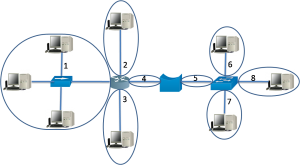
You can see that there are eight collision domains marked in the above topology. The hub is in a single collision domain, or all ports of the hub are in a single collision domain, but each port of the router, bridge, and switch is in a separate collision domain.
Broadcast Domain
A broadcast domain is a logical network segment at Layer 2 (Data Link Layer) where all devices can receive broadcast frames, such as ARP (Address Resolution Protocol) requests or DHCP discoveries. Defined by devices like hubs and switches that forward broadcasts to all ports except the originating one, a broadcast domain impacts network performance. Routers, however, block broadcasts, creating separate domains per interface.
In a large broadcast domain, every device processes all broadcast packets, consuming CPU resources and bandwidth, which can degrade efficiency, especially critical in enterprise networks as of June 2025. Understanding and managing broadcast domains is fundamental for CCNA students to optimize network design and troubleshoot issues.
All the devices in the broadcast domain can be reached via broadcast at the data link layer. A Broadcast Domain can receive any broadcast packet originating from any device within the network segment. All hub and switch ports belong to the same broadcast domain, but all router ports belong to a different broadcast domain.
All ports of the hub and switch are in the same broadcast domain. Hubs and Switches send broadcasts out to all interfaces except the interface on which they were received. Routers do not transmit broadcasts but can handle multicast traffic (e.g., IGMP snooping with ip multicast-routing) to specific groups, offering CCNP-level control over broadcast domains as of June 2025.
Each router interface belongs to a different broadcast domain, and each broadcast is only propagated within its specific domain. Routers separate the boundaries of the broadcast domains. Now, examine the same figure for the broadcast domain.
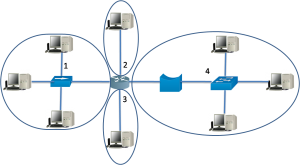
In the figure above, you can see four broadcast domains marked. All ports on a hub, bridge, and switch are in the same broadcast domain, and all interfaces of the router are in a different broadcast domain.
Layer 2 devices send broadcasts known as ARP to a known IPv4 address on the local network to discover the MAC address. The host can get IP address configuration from the DHCP server using the Dynamic Host Configuration Protocol (DHCP). A large broadcast domain can connect many hosts. A problem with a large broadcast domain is that it generates excessive broadcasts and negatively affects the network.
Excessive broadcasts in a large domain consume bandwidth, reducing availability for normal traffic by forcing all devices to process packets, decreasing network performance. It also decreases the processing power of computers and network devices. Because the computers and network devices need to process all the broadcast packets received, a part of the CPU power is spent on processing the broadcast packets.
Subnetting is the process that decreases network traffic, improves network performance, and makes management very easy. We can isolate network segments very quickly using subnetting. We can also apply security policies, such as which subnets are allowed or not to communicate together. There are different ways of using subnets. Network administrators can also set services into subnets, such as:
So we need to decrease the broadcast. To decrease broadcasting, we need to enter a router into the network. The router is an expensive device, so it is not possible to add a router to many networks. Another solution is subnetting, or alternatively, VLANs can segment broadcast domains at Layer 2 (e.g., vlan 10), providing a cost-effective alternative to routers in modern networks as of June, 2025.
- Different floors in a building
- Different Organizations
- A different section of the organization
- Types of Different Devices, such as servers, printers, and hosts
- Any other division that makes sense for the network?
ARP Storm Impact and Mitigation
A large broadcast domain can trigger an ARP storm, where excessive ARP requests flood the network due to misconfigurations or loops (e.g., spanning tree issues). This causes CPU spikes, bandwidth loss, and potential outages. Mitigation includes subnetting (e.g., dividing 192.168.1.0/24 into /26 subnets) to reduce domain size or enabling Dynamic ARP Inspection (DAI) on Cisco switches with ip arp inspection vlan 10
Tools for Analyzing Collision and Broadcast Domains
Use Wireshark to capture packets and filter for ARP broadcasts (e.g., arp filter). On Cisco devices, show mac address-table lists devices per collision domain, and show ip arp details broadcast activity, aiding CCNA/CCNP troubleshooting as of June 2025.
Collision and Broadcast Domains in IPv6
IPv6 minimizes broadcasts by using multicast addresses (e.g., FF02::1 for all nodes, FF02::2 for routers), reducing domain impact. Collision domains remain relevant in Ethernet-based IPv6 networks, managed by switches. Broadcast domains are segmented with /64 prefixes, a modern approach as of June 2025.
FAQs
What is a collision domain and how does it affect network performance?
A collision domain is a network segment where packet collisions occur if devices transmit simultaneously, reducing efficiency; switches mitigate this by creating separate domains, a key CCNA concept as of June 2025.
How do switches differ from hubs in managing collision domains?
Switches create a separate collision domain per port, enabling full-duplex communication, while hubs share a single collision domain, limiting to half-duplex, improving performance in modern networks.
What is a broadcast domain and why is it important?
A broadcast domain is a network segment where all devices receive Layer 2 broadcasts (e.g., ARP), impacting performance; managing it is crucial for scalability, a foundational topic for CCNA students.
How can subnetting reduce broadcast traffic?
Subnetting divides a network into smaller segments, limiting broadcast scope and reducing traffic load, a practical strategy for optimizing network performance as of June 2025.
What causes an ARP storm and how can it be mitigated?
An ARP storm results from excessive ARP requests in a large broadcast domain, causing network strain; mitigation includes subnetting or enabling Dynamic ARP Inspection (DAI) on switches.
How do collision domains apply to virtualized networks in 2025?
In virtualized networks, collision domains are managed by virtual switches, adapting traditional Ethernet concepts to cloud environments, relevant to current CCNP studies as of June 29, 2025.
Can VLANs replace routers for broadcast domain separation?
Yes, VLANs can segment broadcast domains at Layer 2, offering a cost-effective alternative to routers, a valuable technique in CCNP network designs as of June 2025.

